|
If you thought director René Cardona was borrowing ideas from the Batman TV series of the 1960s for Santo vs. the Riders of Terror and The Panther Women, just wait until you get a load of his 1968 La mujer murcielago, which – oh yes – translates literally as The Bat Woman. And unlike the masked wrestling crimefighters in those above-mentioned films (both of which have been simultaneously released on Indicator Blu-ray), we don't have to wait long to meet her.
Following a title sequence that plays out to the sort of swinging sixties tune that Austin Powers would think was groovy, the dead body of wrestler El Rayo is found floating in the sea at Acapulco by two men while out fishing for their supper. It turns out this is the fifth such unnatural death, and the curiously unnamed local police Inspector (Crox Alvarado) suspects they may all be linked to similar murders committed in Macau and Hong Kong a while ago. That theory aside, he and his equally anonymous assistant are completely stumped. Fortunately for them, the International Intelligence Bureau (probably not a real thing) has taken an interest in the case and sent agent Mario Robles (Héctor Godoy) to head up the investigation. On arriving, the first thing Mario tells the Inspector is that he's called in some outside help in the shape of the titular Bat Woman. Well he's certainly earning his government paycheque. We quickly learn that the Bat Woman is in truth a rich socialite named Gloria (Maura Monti), who masquerades as a costumed crime fighter and has also made her name as a luchadora enmascarada, or masked female wrestler. Well, of course she has. Her true identity is only known by investigator Robles and international agent Tony Roca (Armando Silvestre), and just seconds after Mario has told us all about her, she parachutes onto the Acapulco beach in full costume and joins the rest of the team in the medical examiner's office. The autopsy on El Rayo reveals that fluid has been extracted from his pineal gland, the same fate that befell the other murder victims. Why would anyone do that? Beats this lot. Mind you, a quick bit of research confirms the claim made by the coroner that we know less about the pineal gland than any other part of the body is unexpectedly genuine. Consider me enlightened.
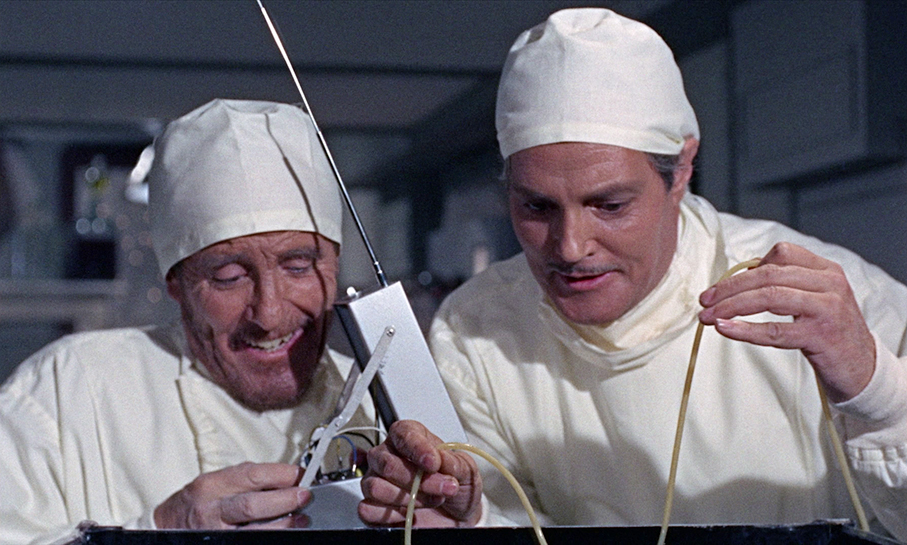
We then meet the evil genius responsible for these crimes in the shape of Dr. Eric Williams (Roberto Cañedo), and the film switches from Batman to Frankenstein mode. The doc even has a loyal assistant named Igor (an uncredited Carlos Suáres), for pity's sake. It turns out that he's using fluid from the pineal gland of strong individuals such as wrestlers in an effort to create an amphibious fish/man hybrid, but so far all of his experiments have failed. Helping him to locate potential new victims is José (David Silva), who masquerades as a blind lottery ticket seller and is a regular visitor at the local wrestling gym. On this occasion he brings good news to a wrestler named Sueco, having secured for him a knock-down price on a boat for a fishing trip he has been looking forward to taking. A short while later, José is on the phone identifying himself as Number One and telling someone named Number Three to reassure Dr. Williams that it's all set up for this afternoon. Sounds highly suspicious to me, yet despite listening in on a basement wiretap, Bat Woman fails to put the pieces together. She's thus far more surprised than we are when Sueco is grabbed from his boat by a gaggle of frogmen and taken to Dr. Williams' yacht, which is not a yacht at all but a sightseeing cruiser. I'm guessing that's the only seafaring vessel that the filmmaker's could afford. Maybe it was José that secured it for them. This time the experiment is a success, creating a small, fish-sized hybrid creature that Williams names Piscis and somehow enlarges to the size of a man in seconds by having it taken underwater and bombarding it with radiation. The result transforms this element of the film from Frankenstein into Creature from the Acapulco Lagoon.
Oh, where do I start with The Bat Woman? As movie, it's the most cheerfully preposterous of the trio released by Indicator in March of this year, as well as having the least convincingly hard-ass heroine. Gloria is played by Italian-born actress and former model Maura Monti, who unlike the majority of the masked male crime fighters of the Santo films, has clearly not also trained as a wrestler. Of course, the same is also true of Loreta Venus and Golden Rubí in The Panther Women, but Ariadne Welter and Elizabeth Campbell still convinced as luchadora tough girls nonetheless. As self-reliant glamorous jet-setter Gloria, Monti certainly shines, but as a tough crime-fighter capable of taking on an army of thugs, I was somewhat less convinced. Indeed, a couple of limp karate chops and a smoothly executed wrestling throw aside, it looks suspiciously like she is able to battle her way past a shipload of Dr. Williams' goons because they've never been in a real fight in their lives. One she bypasses just by pushing him over. She's far more impressive when battling a wrestling opponent in the ring, but that's because it's clearly not her under that full body Bat Woman costume, unless she quickly gained some weight and developed stockier legs specifically for the match.
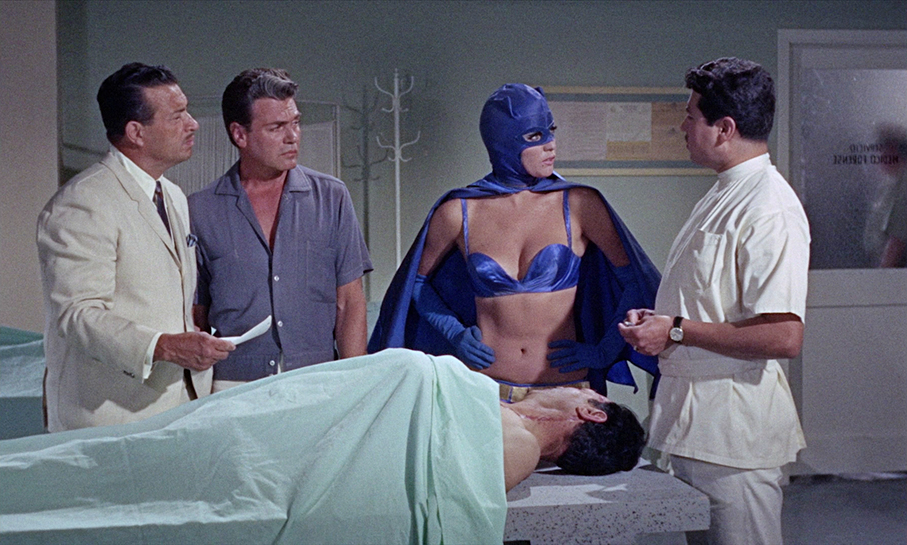
The filmmakers were cleared entranced by Monti's beauty and body. Take Gloria's costume, which is lifted almost wholesale from that of Adam West's Batman, complete with blue cape, cowl, gloves and boots, but with West's grey body suit replaced by a blue bikini. And when Gloria retires at night, they dress her in the sort of lacy baby-doll nightie that was doubtless designed to get male audience members drooling. She may be a self-reliant crime fighter, but let's make her sexy! And then we have Mario and Carlo, who despite praising Gloria's abilities and bringing her on board to effectively do their job for them, are too quick to suggest that she is mistaken when she tells them about having seen the smaller incarnation of Piscis on Williams' boat. Ah, the long and weary movie tradition of men not believing women when they see something potentially dangerous continues unabated. Quite why Gloria is so quickly recruited at all is a bit of a mystery. As an investigator, she does nothing that couldn't have been done by an even half-competent lawman, though this is far from unusual in a genre in which the police are often useless dolts. She also does something so utterly illogical after discovering a tracking device attached to her cape that it had me screaming "What the hell are you doing?" at the screen. There's possibly an argument to be made that a 1968 Mexican audience was not yet ready for a genuinely tough and fully independent heroine, despite the fact that director Cardona's previous luchadora films had such women in abundance. And while I'm not about to reveal the outrageously patronising way in which the film 'comically' ends, feminists may want to get the petrol and matches ready.
Yet despite all of that, there's a camp, low budget, don't-give-a-crap B-movie cheerfulness to The Bat Woman that I found genuinely hard to resist. When Dr. Williams cackles wildly at his success, my jaw dropped a little in disbelief, but when it happens a second time I began to suspect that director Cardona was having a laugh, in the literal rather than pejorative sense. I mean, come on, a mad scientist who gets his face horribly scarred by acid thrown by the heroine, has a devoted assistant named Igor, and dreams of creating an army of hundreds of fish-men to take control of the seas of the world? How could that not put a nostalgic smile on your face? The hand-to-hand combat may not really convince, and if you've ever wondered how to make a potentially thrilling car chase and feel dull and overlong, then Cardona's your man. But while the execution may intermittently stumble, other scenes are handled with aplomb, the best of which are the underwater sequences, masterfully shot by Genaro Hurtado, in which Monti does her own diving, and borrowings from Thunderball and The Creature from the Black Lagoon are put to captivating use.
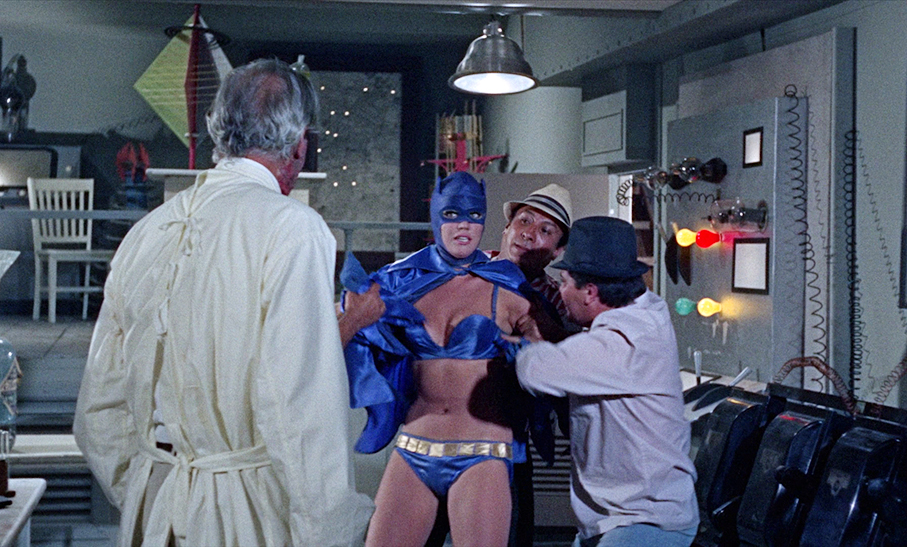
The decision to build a film around a multi-talented, crime-fighting heroine in what was then a very male-genre dominated genre is definitely worth applauding, and as a female friend of mine is fond of pointing out, a woman shouldn't have to dress and act like a man to be seen as an equal. That's certainly true of our Gloria – she wears what she likes, and if you try to take advantage then she'll kick your sorry chauvinistic male arse into the middle of next week. That's the theory, at least. She may work with two good-looking men who find her attractive, but despite their above-cited questioning of her judgement, they both respect her abilities, and a romantic relationship with either of them is never on the cards. A few years down the line and with longer shooting schedule and a larger budget, I've no doubt that the combat would have been more hard-hitting and the car chase more exciting, particularly given the possibilities of the location on which it was shot and the considerable impact of the chase scene in the same year's Bullitt. And you know what, the man-fish creature costume is pretty darned good given the monetary restrictions under which the filmmakers doubtless had to work. If you can cope with its wobblier aspects, The Bat Woman is still a lot of unpretentious fun, and news that the notoriously litigious DC Comics didn't even bother to file a suit against the filmmakers made me appreciate their audacity and brazen cheek even more.
The Bat Woman was restored in 4K by Permanencia Voluntaria and Cinema Preservation Alliance, in collaboration with Academy Film Archive and Paso Del Norte, from the original camera negatives. Framed in its original aspect ratio of 1.66:1, the 1080p transfer on Indicator's Blu-ray is downright gorgeous, particularly the vibrant presentation of Agustín Jiménez's lively Eastmancolor cinematography. Prime colours in particular really pop, notably the rich blue of the Bat Woman costume. Contrast is also perfectly pitched and the picture detail is crisply rendered. A fine film grain is visible, and almost all traces of dust and damage have been banished.
As with the other two René Cardona lucha libre films released on Blu-ray alongside this one by Indicator, the film's Linear PCM 1.0 mono audio was remastered from the original optical soundtrack. Although generally clear, the inevitable range restrictions do occasionally make themselves felt, with a familiar treble bias resulting in some of the high notes of the music feeling just a little abrasive at a louder volume. There's also a very slight hum in the background, but you'll only really notice this if you have your sound system cranked up high. For the most part, a solid job.
Optional English subtitles are activated by default.
Audio Commentary with David Wilt
In common with his commentary on Santo vs. the Riders of Terror, film historian and Mexican cinema specialist David Wilt provides detailed information on the key cast and crew members, but this time around he spends as much time on the content and style of the film. He acknowledges the unmistakable influence of the Batman TV series and the internationally successful James Bond movies, notes that this was a rare example of female protagonist in a Mexican film that was not a comedy, a musical or a melodrama, and discusses the film's blatant purloining of intellectual property owned by DC Comics. He praises the underwater photography and gives props to the creature costume design, but is merciless when it comes to what he describes as "the world's longest and most boring car chase." There's loads more of real interest here.
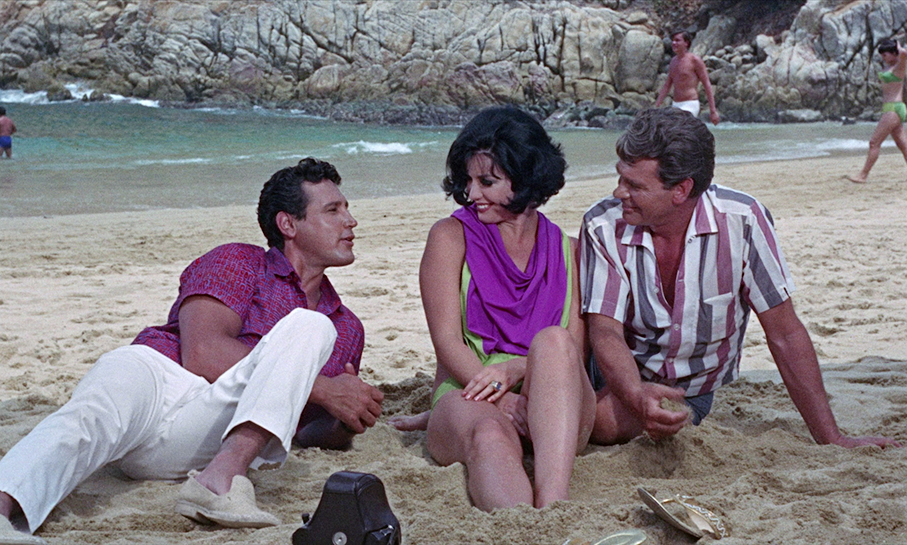
Maura Monti: Bat of Nine Lives (18:23)
An interview with the Bat Woman herself, Maura Fazi Pastorino, aka Maura Monti, in which she looks back at her life and career, including her later retirement from acting and the founding of her own school at a particularly volatile time in Mexican history. Although she was born in Italy and became a model and actress after moving to Mexico with her mother, I was completely unaware that she spent part of her childhood in England and was apparently sent to school in Tunbridge Wells "for disciplinary reasons." She elects not to elaborate on exactly what errant behaviour prompted this move, or indeed why Tunbridge Wells was considered an appropriate punishment. It didn't seem that bad last time I was there. She describes René Cardona as "a very funny man," and there's the unspoken suggestion that his son was of a somewhat less humorous temperament. She also has fond memories of working with an unwell but "sweet and tender" Boris Karloff on his final film, the not so great 1971 Alien Terror.
Mauricio Matamoros Durán: Adventures in Mexicolour (20:20)
Mauricio Matamoros Durán – journalist, writer, and indie editor of Belcebú and formerly DC Comics – explores the history and evolution of Mexican comic books, the literature and cultural changes and icons from which they drew inspiration, and how they helped to shape genre cinema of the day. Logically, The Bat Woman is specifically discussed, in part for its presentation of "an idyllic, fanciful and exuberant Mexico" at a time when this image of the country was being promoted. Fascinating stuff, though I did smile a little when Durán remarks on the "amazing athletic and investigative skills" and "great physical strength" of the Bat Woman. What, this Bat Woman?
José Luis Ortega Torres: Fantastique Creatures (13:53)
Film critic, teacher, and author of the book Mostrología del cine mexicano, José Luis Ortega Torres, focusses on the man-fish creature in The Bat Woman, its precedents in Mexican cinema, the influence of Jack Arnold's The Creature from the Black Lagoon, and the cycle of genre films in the 1950s and 60s built around robot characters. Once again, I learned a lot from this.
Theatrical Trailer (3:06)
The lively original Mexican theatrical trailer, framed 4:3 and sporting slightly washed-out colour and a fair few specs of wear, leans into the film's cheesier B-movie elements and adds a dash of its own in the shape of the almost comical growls it dubs onto the fish-man to make him seem more animalistic.
Image Gallery
82 screens of promotional stills (some excellent quality), lobby cards and posters, one of which makes no secret of the fact that the film is riffing off the Batman TV series.
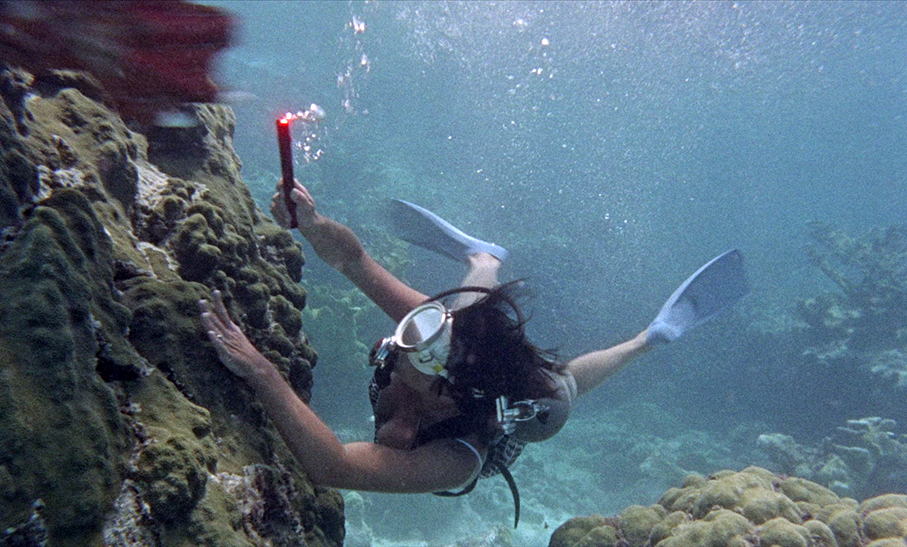
Booklet
At 78 pages, this booklet sits on the cusp of being reclassified as a book, and as ever with Indicator, it's packed full of informative reads. Leading the way is an essay on The Bat Woman by Dolores Tierney, who is professor of film and head of film studies at the University of Sussex and author of several books on Latin-American cinema. It's a fascinating piece that discusses the film in the context of Mexican genre cinema and the rise in popularity of lucha dore movies, as well as its emerging status as a cult favourite. Next up are extracts from three newspaper articles from 1967 in which lead actress Maura Monti talks about how the public image of her as a person is too often shaped by the roles she plays on screen, and how she fought for parts in which she could demonstrate her acting ability rather than be cast for her glamour and be dressed in a bikini. If you're new to the cinema of René Cardona then you'll doubtless welcome the next piece as warmly as I did, a biography of his life and work taken from Dictionary of Mexican Film Directors. This is followed by extracts from Doyle Green's 2005 book Mexploitation Cinema: A Critical History of Mexican Vampire, Wrestler, Ape-Man and Similar Films, 1957-1977 that take a detailed look at René Cardona's luchadoras movies, including The Bat Woman, which Green describes amusingly as a "bewildering classic." Finally, the rise of lucha libre cinema is explored in a 1987 Film Comment article by Andrew Coe, which includes quotes from several Mexican industry veterans, René Cardona included.
The daftest of the three lucha libre films released last month on Blu-ray by Indicator is still a good deal of fun for devotees of low-budget cinema of appropriation, fans of 50s monster movies, and anyone who has succumbed to the peculiar attraction of the Mexican lucha libre genre. The presentation is excellent, and once again I learned a ton from the well-targeted special features. A film that will have some holding their heads in their hands in disbelief, but if this is your bag, baby, then you can't go wrong with this excellent disc.
|